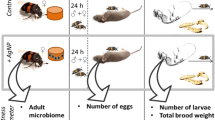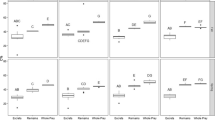Abstract
Coal-burning power plants supply approximately 37 % of the electricity in the United States. However, incomplete combustion produces ash wastes enriched with toxic trace elements that have historically been disposed of in aquatic basins. Organisms inhabiting such habitats may accumulate these trace elements; however, studies investigating the effects on biota have been primarily restricted to shorter-lived, lower-trophic organisms. The American alligator (Alligator mississippiensis), a long-lived, top-trophic carnivore, has been observed inhabiting these basins, yet the health or immune effects of chronic exposure and possible accumulation remains unknown. In this study, we investigated how chronic dietary ingestion of prey contaminated with coal combustion wastes (CCWs) for 25 months, and subsequent accumulation of trace elements present in CCWs, affected juvenile alligator immune function and health. Alligators were assigned to one of four dietary-treatment groups including controls and those fed prey contaminated with CCWs for one, two, or three times a week. However, no effect of Dietary Treatment (p > 0.05) was observed on any immune parameter or hematological or plasma analyte we tested. Our results suggest that neither exposure to nor accumulation of low doses of CCWs had a negative effect on certain aspects of the immune and hematological system. However, future studies are required to elucidate this further.




Similar content being viewed by others
References
Abbas AK, Lichtman AH, Pillai S (2010) Cellular and molecular immunology. Elsevier, Philadelphia
Allsteadt J, Lang JW (1995) Sexual dimorphism in the genital morphology of young American alligators, Alligator mississippiensis. Herpetologica 51:314–325
Beck ML, Hopkins WA, Hawley DM (2014) Relationships among plumage coloration, blood selenium concentrations and immune responses of adult and nestling tree swallows. J Exp Biol 218:3415–3424
Brown GP, Shilton CM, Shine R (2011) Measuring amphibian immunocompetence: validation of the phytohemagglutinin skin-swelling assay in the cane toad, Bufo marinus. Method Ecol Evol 2:341–348
Burger J, Gocheild M, Rooney AA, Orlando EF, Woodward AR, Guillette LJ Jr (2000) Metals and metalloids in tissues of American alligators in three Florida lakes. Arch Environ Contam Toxicol 38:501–508
Campbell KR (2003) Ecotoxicology of crocodilians. Appl Herpetol 1:45–163
Campbell JW, Waters MN, Tarter A, Jackson J (2010) Heavy metal and selenium concentrations in liver tissue from wild American alligator (Alligator mississippiensis) livers near Charleston, South Carolina. J Wildl Dis 46:1234–1241
Cherry DS, Rodgers JH Jr, Cairns J Jr, Dickson KL, Guthrie RK (1976) Responses of mosquitofish (Gambusia affinis) to ash effluent and thermal stress. Trans Am Fish Soc 105:686–694
Conroy CJ, Papenfuss T, Parker J, Hahn NE (2009) Use of tricaine methanesulfonate (MS222) for euthanasia of reptiles. J Am Assoc Lab Sci 48:28–32
Dangleben NL, Skibola CF, Smith MT (2013) Arsenic immunotoxicity: a review. Environ Health 12:73
Delany MF (1990) Late summer diet of juvenile American alligators. J Herpetol 24:418–421
Delany MF, Abercrombie CL (1986) Alligator food habits in Northcentral Florida. J Wildl Manag 50:348–353
Demas GE, Zysling DA, Beechler BR, Muehlenbein MP, French SS (2011) Beyond phytohaemagglutinin: assessing vertebrate immune function across ecological contexts. J Anim Ecol 80:710–730
Fairbrother A, Fowles J (1990) Subchronic effects of sodium selenite and selenomethionine on several immune functions in mallards. Arch Environ Contam Toxicol 19:836–844
Fairbrother A, Fix M, O’Hara T, Ribic CA (1994) Impairment of growth and immune function of avocet chicks from sites with elevated selenium, arsenic, and boron. J Wildl Dis 30:222–233
Finger JW Jr, Gogal RM Jr (2013) Endocrine-disrupting chemical exposure and the American alligator: a review of the potential role of environmental estrogens on the immune system of a top trophic carnivore. Arch Environ Contam Toxicol 65:704–714
Finger JW Jr, Isberg SR (2012) A review of innate immune functions in crocodilians. CAB Rev 7:1–11
Finger JW Jr, Adams AL, Thomson PC, Shilton CM, Brown GP, Moran C, Glenn TC et al (2013) Using phytohaemagglutinin to determine immune responsiveness in saltwater crocodiles (Crocodylus porosus). Aust J Zool 61:301–311
Finger JW Jr, Thomson PC, Adams AL, Benedict S, Moran C, Isberg SR (2015a) Reference levels for corticosterone and immune function in farmed saltwater crocodiles (Crocodylus porosus) hatchlings using current Code of Practice guidelines. Gen Comp Endocrinol 212:63–72
Finger JW Jr, Williams RJ, Hamilton MT, Elsey RM, Oppenheimer VA, Holladay SD et al (2015b) Influence of collection time on hematologic and immune markers in the American alligator (Alligator mississippiensis). J Immunoass Immunochem 36:496–509
Franklin CE, Davis BM, Peucker SKJ, Stephenson H, Mayer R, Whittier J et al (2003) Comparison of stress induced by manual restraint and immobilisation in the estuarine crocodile, Crocodylus porosus. J Exp Zool 298:86–92
Glassman AB, Holbrook TW, Bennett CE (1979) Correlation of leech infestation and eosinophilia in alligators. J Parasitol 65:323–324
Guillette LJ, Woodward AR, Crain DA, Masson GR, Palmer BD, Cox C et al (1997) The reproductive cycle of the female American alligator (Alligator mississippiensis). Gen Comp Endocrinol 108:87–101
Haley P, Perry R, Ennulat D, Frame S, Johnson C, Lapointe JM et al (2005) STP position paper: best practice guideline for the routine pathology evaluation of the immune system. Toxicol Pathol 33:404–407
Hamilton MT, Finger JW Jr, Winzeler ME, Tuberville TD (2016a) Evaluating the effect of sample type on American alligator (Alligator mississippiensis) analyte values in a point-of-care analyser. Conserv Physiol 4:1–7
Hamilton MT, Kupar CA, Kelley MD, Finger JW Jr, Tuberville TD (2016b) Blood and plasma biochemistry reference intervals for wild juvenile American alligators (Alligator mississippiensis). J Wildl Dis 52:631–635
Hoffman PR (2007) Mechanisms by which selenium influences immune responses. Arch Immunol Ther Exp 55:289–297
Hopkins WA, Mendcona MT, Congdon JD (1997) Increased circulating levels of testosterone and corticosterone in southern toads, Bufo terrestris, exposed to coal combustion waste. Gen Comp Endocrinol 108:237–246
Hopkins WA, Mendonca MT, Rowe CL, Congdon JD (1998) Elevated trace element concentrations in southern toads, Bufo terrestris, exposed to coal combustion waste. Arch Environ Contam Toxicol 35:325–329
Hopkins WA, Rowe CL, Congdon JD (1999) Elevated trace element concentrations and standard metabolic rate in banded water snakes (Nerodia fasciata) exposed to coal combustion wastes. Environ Toxicol Chem 18:1258–1263
Hopkins WA, Roe JH, Snodgrass JW, Staub BP, Jackson BP, Congdon JD (2002) Effects of chronic dietary exposure to trace elements on banded water snakes (Nerodia fasciata). Environ Toxicol Chem 21:906–913
Hopkins WA, Staub BP, Baionno JA, Jackson BP, Roe JH, Ford NB (2004) Trophic and maternal transfer of selenium in brown house snakes (Lamprophis fuliginosus). Ecotox Environ Safe 58:285–293
Hughes MR, Smits JE, Elliot JE, Bennett DC (2000) Morphological and pathological effects of cadmium ingestion on pekin ducks expose to saline. J Toxicol Environ Heatlh A 61:591–608
Isberg SR, Thomson PC, Nicholas FW, Barker SC, Moran C (2005) Quantitative analysis of production traits in saltwater crocodiles (Crocodylus porosus): II. Age at slaughter. J Anim Breed Genet 122:370–377
Lance V, Elsey RM (1999) Hormonal and metabolic responses of juvenile alligators to cold shock. J Exp Zool 283:566–572
Lance V, Joanen T, McNease L (1983) Selenium vitamin E and trace elements in the plasma of wild and farm-reared alligators during the reproductive cycle. Can J Zool 61:1744–1751
Lang JW, Andrews HV (1994) Temperature-dependent sex determination in crocodilians. J Exp Zool 270:28–44
Lemly AD, Skorupa JP (2012) Wildlife and the coal waste policy debate: proposed rules for coal waste disposal ignore lessons from 45 years of wildlife poisoning. Environ Sci Technol 46:8595–8600
Lovely CJ, Pittman JM, Leslie AJ (2012) Normal haematology and blood biochemistry of wild Nile crocodiles (Crocodylus niloticus) in the Okavango Delta, Botswana. J S Afr Vet Assoc 78:137–144
Milnes MR, Guillette LJ Jr (2008) Alligator tales: new lessons about environmental contaminants from a sentinel species. Bioscience 58:1027–1036
Morgan BP, Gasque P (1997) Extrahepatic complement biosynthesis: where, when and why? Clin Exp Immunol 107:1–7
National Research Council (2006) Managing coal combustion residues in mines. National Academies Press, Washington, DC
Qin X, Gao B (2006) The complement system in liver diseases. Cell Mol Immunol 3:333–340
Roe JH, Hopkins WA, Baionno JA, Staub BP, Rowe CL, Jackson BP (2004) Maternal transfer of selenium in Alligator mississippiensis nesting downstream from a coal-burning power plant. Environ Toxicol Chem 23:1969–1972
Romero LM, Reed JM (2005) Collecting baseline corticosterone samples in the field: is under 3 min good enough? Comp Biochem Physiol A 140:73–79
Rooney AA, Bermudez DS, Guillete LJ Jr (2003) Altered histology of the thymus and spleen in contaminant-exposed juvenile American alligators. J Morphol 256:349–359
Rowe C, Kinney O, Fiori A, Congdon J (1996) Oral deformities in tadpoles (Rana catesbeiana) associated with coal ash deposition: effects on grazing ability and growth. Freshw Biol 36:723–730
Rowe CL, Hopkins WA, Zehnder C, Congdon JD (2001) Metabolic costs incurred by crayfish (Procambarus acutus) in a trace element-polluted habitat: further evidence of similar responses among diverse taxonomic groups. Comp Biochem Physiol C 129:275–283
Rowe CL, Hopkins WA, Congdon JD (2002) Ecotoxicological implications of aquatic disposal of coal combustion residues in the United States: a review. Environ Monit Assess 80:207–276
Savabieasfahani M, Lochmiller RL, Sinclair JA (1998) Sensitivity of wild cotton rats (Sigmodon hispidus) to the immunotoxic effects of low-level arsenic exposure. Arch Environ Contam Toxicol 34:289–296
Sellers RS, Morton D, Michael B, Roome N, Johnson JK, Yano BL et al (2007) Society of Toxicologic Pathology position paper: organ weight recommendations for toxicology studies. Toxicol Pathol 35:751–755
Sykes JM, Klaphake E (2008) Reptile hematology. Vet Clin Exotic Anim Practice 11:481–500
Thrall MA, Weiser G, Allison RW, Campbell TW (eds) (2012) Veterinary hematology and clinical chemistry, 2nd edn. Wiley-Blackwell, Ames
Tuberville TD, Scott DE, Metts BS, Finger JW, Hamilton MT (2016) Hepatic and renal trace element concentrations in American alligators (Alligator mississipiensis) following chronic dietary exposure to fly ash contaminated prey. Environ Pollut 214:680–689
United States Energy Information Administration (2014) Electric power monthly, April 2016. United States Department of Energy, Energy Information Administration, Washington, DC. http://www.eia.gov/electricity/monthly/pdf/epm.pdf
Warner JK, Combrink X, Myburgh JG, Downs CT (2016) Blood lead concentrations in free-ranging Nile crocodiles (Crocodylus niloticus) from South Africa. Ecotoxicology 25:950–958
Wayland M, Gilchrist HG, Marchant T, Keating J, Smits JE (2002) Immune function, stress response, and body condition in Arctic-breeding common eiders in relation to cadmium, mercury, and selenium concentrations. Environ Res 90:47–60
Webb GJW, Messel H (1978) Morphometric analysis of Crocodylus porosus from the north coast of Arnhem Land, Northern Australia. Aust J Zool 26:1–27
Woodward AR, White JH, Linda SB (1995) Maximum size of the alligator (Alligator mississippiensis). J Herpetol 4:507–513
Zayas MA, Rodriguez HA, Galoppo GH, Stoker C, Durando M, Luque EH et al (2011) Hematology and blood biochemistry of young healthy broad-snouted caimans (Caiman latirostris). J Herpetol 45:516–524
Acknowledgments
Support was provided in part by Award Number DE-FC09-07SR22506 from Department of Energy to the University of Georgia Research Foundation. All experimental protocols were approved by the Institutional Animal Care and Use Committee at the University of Georgia (Approval No. A2010 11-561-Y3-A3). J. W. F. was funded by the Interdisciplinary Toxicology Program and the Department of Environmental Health Science at the University of Georgia. MTH and all sample analysis was funded by a grant from the Area Closures Project to T. D. T. We thank David E. Scott and Stacey L. Lance for their assistance with project design and dissections. Brett DeGregorio was instrumental in setting up the experimental tanks; Caitlin Kupar assisted with the collection of prey, and Matthew Atkinson helped conduct PHA assays on alligators. We would also like to thank John Seaman at SREL for guidance on tissue digestions and data interpretation. Thanks must also be extended to Suresh Benedict at Berrimah Veterinary Laboratories in Berrimah, NT, Australia, for advisement on BKAs and to Peter C. Thomson at the University of Sydney for statistical insight.
Author information
Authors and Affiliations
Corresponding author
Rights and permissions
About this article
Cite this article
Finger, J.W., Hamilton, M.T., Metts, B.S. et al. Chronic Ingestion of Coal Fly-Ash Contaminated Prey and Its Effects on Health and Immune Parameters in Juvenile American Alligators (Alligator mississippiensis). Arch Environ Contam Toxicol 71, 347–358 (2016). https://doi.org/10.1007/s00244-016-0301-9
Received:
Accepted:
Published:
Issue Date:
DOI: https://doi.org/10.1007/s00244-016-0301-9




